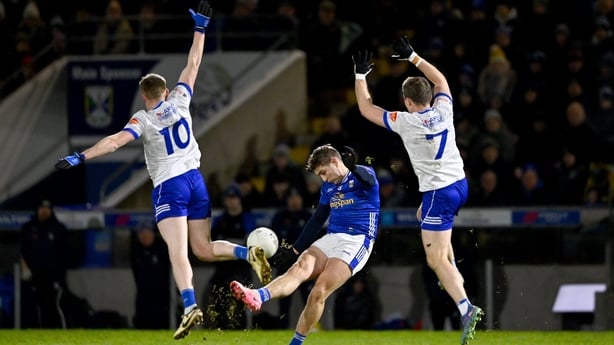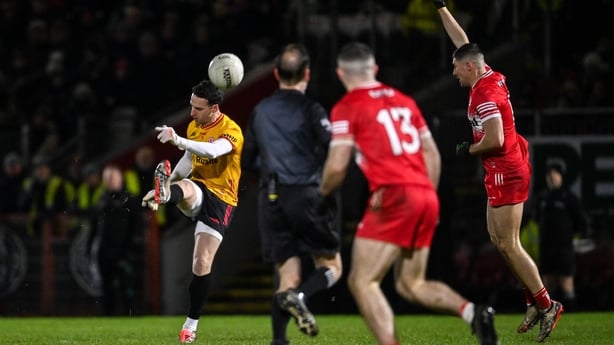Not spectacular enough to win over the sceptics and not enough of a disaster to dissuade the optimists – the GAA's new rules made a tepid enough full league debut.
Ironically, the most controversial football decision of the weekend came under the old rules as Ballinderry’s All-Ireland Intermediate dreams were ruined by a horrible penalty call at the end – although nobody was begrudging Crossmolina, and Conor Loftus in particular, after recent tragic events.
In the Allianz League, there were certainly moments of confusion, some controversies, but not loud enough to swing the judgement decisively one way or another.
Speaking during RTÉ’s coverage of Galway’s win over Armagh, Éamonn Fitzmaurice confirmed that the Football Review Committee can make changes as they see fit, and they probably already have some issues to ponder. Other areas would have left them very pleased.
Here’s are some key points from round one of new-look football.
Scoring patterns – and why more doesn’t necessarily mean better
In their five previous seasons in Division 2, Down never managed more than the 1-20 they hit against Roscommon on Sunday, matching it once with a 2-17 tally against Westmeath in 2015. In Mullingar, they won by 13 points, yesterday they lost by seven.
If we are to take 20 points as being the very high watermark that teams strived to hit under the old rules, there were further good signs.
Again comparing to last year’s league, the 16 round one games in 2024 saw three teams manage to hit the mark. Over the weekend, the 13 games that beat the weather enabled 11 teams to reach 20 with another seven hitting over 18.
It is a significant rise and a real boon for the committee, although it must be remembered that the addition of two-pointers means that the rate of scoring didn’t rise as much as it did on the scoreboard.
A note of caution though, score after score after score isn’t always exclusively positive.

A few years ago, a statistical study was carried out looking at the top 200 shot locations in the NBA in 2001/02 compared to 2019/20.
The results were startling. In the earlier example, shots were taken from every area inside the three-point line and at just at key spots outside the line.
Now, and with three-point extraordinaire Steph Curry cited as the main reason why, the heatmap shows red all around the three-point line while inside there is only really activity under the basket as teams nab rebounds.
Having started out at about 3% of all shots and with a one in four conversion rate in 1979-80, last year’s NBA regular season saw 36 players hit 100 or more three-pointers with teams taking between 30.5% (Orlando) and 39.8% (Cleveland) of their shots from outside the line. Higher skill levels? Absolutely. A better product? Few basketball fans would say yes.
Closer to home, hurling’s high point taking of recent times has led to calls for the trial of a four-point goal from the likes of RTÉ hurling analyst Anthony Daly.
Given football’s ills of recent times, the higher scores must be viewed as a positive though and a direct result of the 'three up’ rule that worked well with teams really tuned in. Mostly...
Arc’s free hit
In the 54th minute of Galway’s Division 1 clash with Armagh, the hosts were just a goal up and the game felt like it was entering its crucial zone.
Stefan Campbell snagged a break ball in midfield and the All-Ireland champions were about to go on the attack when Conor Lane, under instruction of line umpire Kieran Eannetta, blew his whistle.
Armagh had broken the ‘three up’ rule so Galway had a free on their opponent’s 20-metre line.
As was his right, Shane Walsh opted to take the ball straight back to the edge of the arc meaning he had a 40-metre free in front of the posts with a gale behind him for a simple two points, turning a three-point lead into five points.
It was clearly too generous and for that reason, not many teams are going to opt for the tap over from 20 metres when a bigger bounty awaits. Some 19 of the 47 two-pointers over the weekend were from frees.
Another Galway two-pointer, this time from Shane Walsh
— RTÉ GAA (@RTEgaa) January 25, 2025
Follow the action on TV, radio and online:
📺 https://t.co/Bop1JL4SK1
🖥️ https://t.co/J8TQrTSOIT
📻 https://t.co/OTS6LGH75k #RTEgaa pic.twitter.com/L1gH6G2aHT
It seems quite clear that it’s too rewarding, and the answer seems to be limiting two-point scores to efforts from play only.
The opposition to such a change is that it will encourage fouling, but that’s highly debatable.
Scores from play are much more difficult given things like body shape, opposition pressure and a lack of space. The conversion rate from play versus frees outside the arc will be very different so a fouling defender will likely give up a guaranteed point whereas a two-pointed effort from play will carry more jeopardy for the shooter.
And if a player’s xP (that term’s coming!) is up around 2 from play, it’s unlikely any opposition player is close enough to foul anyway.
Solo and go, go, go
Of all the rules, this appears the most clear and obvious success.
It speeds up the games, it starts attacks before defences can get set up and rewards teams that are switched on.
Goalkeeper inventiveness
The rise and rise of the goalkeeper shows no sign of slowing down even if part of the reason the rules were introduced was to stop them taking the ball deep with no pressure and slowing the game down.
Despite protestations from Derry boss Paddy Tally that it’s "killing the game" as teams can now create a 12v11 situation in the opposite half when the goalkeeper arrives, it was interesting to see them having such a big influence on proceedings - even if plenty disagree.
Mayo’s Colm Reape, Offaly’s Paddy Dunican, Meath’s Billy Hogan, Monaghan’s Rory Beggan, Cavan’s Gary O’Rourke and Fermanagh’s Ross Bogue all scored from play over the weekend.
Tyrone's Niall Morgan didn't score but came forward to great effect and played a beautiful pass to set up Peter Teague's goal to break Derry's resistance while other counties showed some inventiveness.
With Armagh chasing the game against Galway, Ethan Rafferty was sprung from the bench to replace Blaine Hughes and made a real impact up the pitch.

Down, likewise, were in need of something different late on against Roscommon and Conor Laverty took off goalkeeper John O’Hare with outfielder Danny Magill moving into goal as they planned to play essentially without a keeper. As it was, the Rossies dominated the ball from there so there was little chance for that plan to kick into action with the Burren man actually making a smart save with his feet.
That aforementioned 12v11 advantage means that sideways hand-passing is not eliminated from the game, but it can only happen in the opposition half and with that comes a higher risk.
Down found that out as Odhran Murdock was brilliantly blocked down by Colm Neary with O’Hare pushing high. One long pass later with no cover and Ciaran Murtagh was picking up possession and brilliantly finishing to an empty net from 40 metres.
Foam-ing it in
Small things, but referees were using foam at places like Croke Park and Kingspan Breffni while it was absent at other grounds.
The hooter system being used in Division 1 only - which will be the case also for round 2 - seemed a bit untidy too.
By the end of the league, it will be in place in all four divisions which begs the question, why couldn't it have been there from the start?
Watch Armagh v Tyrone in the Allianz Football League on Saturday from 5.30pm on RTÉ2 and RTÉ Player. Follow a live blog on rte.ie/sport and the RTÉ News app. Listen to Saturday Sport on RTÉ Radio 1
Watch Allianz League Sunday from 9.30pm on RTÉ2 and RTÉ Player. Follow a live blog on all matches on rte.ie/sport and the RTÉ News app. Listen to updates around the country on Sunday Sport on RTÉ Radio 1
Follow the RTÉ Sport WhatsApp channel for the best news, interviews, analysis and features, as well as details of our sports coverage across all RTÉ platforms

